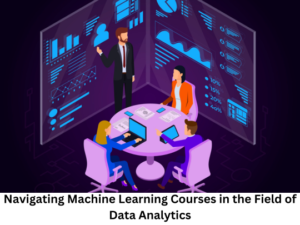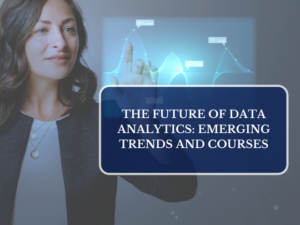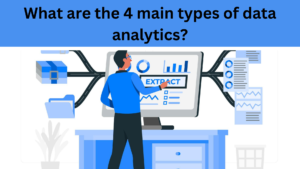Machine learning is one of the most prominent subdomains of big data that is revolutionizing the field of data analytics by making some of the previously time-consuming and challenging tasks done automatically, considering more sophisticated features, and providing potential predictive functionalities. The application of machine learning optimizes the processes, increases the speed and accuracy of data analysis, as well as widens its range. Here’s how machine learning revolutionizes data analytics:Here’s how machine learning revolutionizes data analytics:
1. This step deals with the full automation of data processing and subsequent data analysis.
Efficiency:
• Data Cleaning: The data preparation step can be greatly beneficial from using the machine learning techniques when it comes to identifying and handling the possible errors, outliers as well as missing values.
• Data Transformation: Data preprocessing is critical to getting better model results since raw data is most of the time not directly usable in machine learning algorithms.
Tools and Techniques:
• Natural Language Processing (NLP): Handles text data cleaning operations where text data is converted into tokens and stemmer to determine their sentiment.
• AutoML: Google AutoML and H2O can be considered as some of the tools that can help in building machine learning models. ai automate every stage of building the model ranging from the steps that are followed for the cleaning of the data to selection of the model as well as tuning of the same.
2. Enhancing Predictive Analytics
Predictive Power:
• Forecasting: Predictive analytics is when a machine learning model computes through large amounts of data established in the past to estimate the number of occurrences in the future, which is useful in demand forecasting, predictive stock pricing and so much more.
• Classification and Regression: It includes classifications such as decision trees, support vector machines (SVM), or neural networks, which are instances solving classification or regression.
Applications:
• Retail: Shopping intentions forecasting to manage the available stock and design targeted promotional initiatives.
• Finance: Computation of credit risk, identification of frauds, and predicting the future market trends.
3. Reviewing Issues, Problems, and Facts to Find the Occult
Deep Insights:
• Clustering: Ancillary learning algorithms include k-means and hierarchical clustering in which data points are grouped based on their similarity making it easy to see inherent structures of data.
• Anomaly Detection: Machine learning algorithms are capable of detecting the anomalies and irregularities which may be related to fraud, defect or some other important event.
Applications:
• Healthcare: Diagnosing subgroups of patients for patients’ tailored intervention and diagnosing any abnormalities in the images acquired from the medical equipment.
• Network Security: Making use of systems that will track down on the whole network and work towards the identification of the black activities happening in the real time.
4. Enabling Real-Time Analytics
Speed and Scalability:
• Streaming Analytics: It is a reality as a result of real-time processing and analysis of data that machine learning algorithms help in quick decision making.
• Scalable Solutions: AWS SageMaker and Azure Machine Learning, can be hosted on the cloud, and this means the data processed is almost limitless.
Applications:
• IoT: Monitoring of sensors data for condition based and real-time maintenance and process optimization.
• Customer Service: Real time sentiment analysis for the company and responses that are customized to enhance customer experience.
5. Personalizing Customer Experiences
Customization:
• Recommendation Systems: Automated models enhance the knowledge of the users’ behavior for the purposes of making suggestions regarding availed products, services or material.
• Customer Segmentation: Thus, the clustering algorithms allow the division of customers into a number of groups according to their behavior patterns and demographics, which helps to create specific marketing approaches.
Applications:
• E-commerce: Booking recommendations, price change according to the consumer’s preferences and history.
• Streaming Services: Customized content suggestions for the purpose of improving the level of users’ interest and satisfaction.
6. Improving Decision-Making Processes
Data-Driven Decisions:
• Decision Support Systems: Machine learning models therefore assist businesses in building intelligence tools that will help the decision makers to make decisions with predictions.
• Risk Management: Artificial neural networks approve hypotheses about risks, and suggest measures for their prevention, which increases the efficiency of the decision making in the conditions of considerable uncertainty.
Applications:
• Supply Chain: Improving the supply chain and stock control with the help of forecasts and simulations.
• Human Resources: Optimizing the processes of recruiting and retaining talents focusing on the usage of predictive analytics.
7. Facilitating Advanced Analytics
Complex Analysis:
• Deep Learning: Deep learning neural nets process big data of image, audio, video, etc. , for high level of analytical capabilities which were impossible before.
• Generative Models: Such strategies such as GANs (Generative Adversarial Networks) is dealing with fake data, hence improving on model estimation and evaluation.
Applications:
• Healthcare: Digital Mammography, MRI, fMRI, CT scans, X-ray, Ultrasound, PET and SPECT imaging systems.
• Entertainment: Generating true to life animations and consequent effects in movies and games.
8. Improving the explainability and interpretability capabilities of the model
Explainable AI:
• Model Interpretability: Some strategies such as SHAP (SHapley Additive exPlanations) and LIME (Local Interpretable Model-agnostic Explanations) causes explainability in machine learning models and make people trust the model predictions.
• Bias Detection: Machine learning also has ways of not only detecting but also correcting biases within certain models for fairly and ethically sound results.
Applications:
• Finance: Protecting credit scoring model from unjustified influences or biases.
• Healthcare: Some of the challenges include: Offering ‘’Interpretable’’ predictions for clinical decision support systems.
Useful links
https://azure.microsoft.com/en-us/products/machine-learning
https://skillslash.com/data-science-course-training-kolkata
https://collegedunia.com/courses/data-analytics/data-analytics-courses-in-bangalore
https://www.spiceworks.com/tech/artificial-intelligence/articles/what-is-ml/
https://www.ibm.com/topics/machine-learning
https://www.learnbay.co/datascience/bangalore/data-analytics-course-training-in-bangalore
https://360digitmg.com/malaysia/data-analytics-certification-course-training-institute



